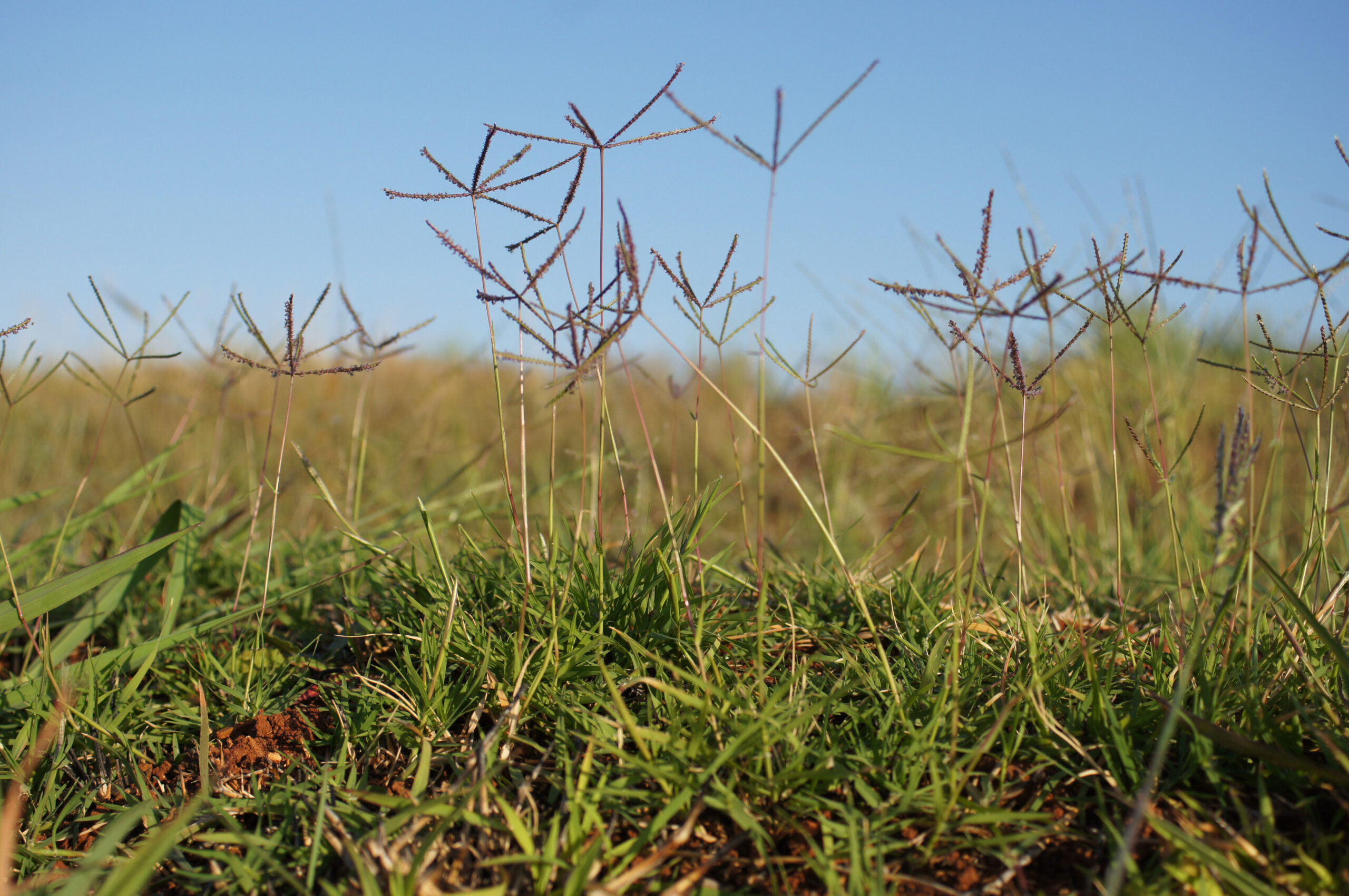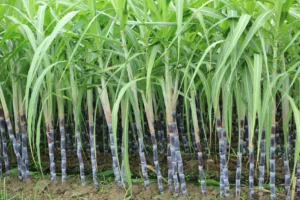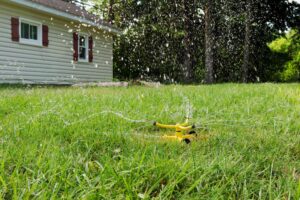How to Keep Bermuda Grass Out of Flower Beds: The Ultimate Guide
Are you fighting a losing battle against Bermuda grass invading your carefully cultivated flower beds? You’re not alone. This tenacious turfgrass, while prized for lawns, becomes a gardener’s nightmare when it creeps into ornamental spaces. With its aggressive growth pattern and remarkable resilience, Bermuda grass can quickly transform your beautiful flower beds into a frustrating mess.
This comprehensive guide will equip you with practical strategies to prevent, control, and eliminate Bermuda grass from your flower beds once and for all. You’ll learn about both preventative measures and eradication techniques that work specifically for this persistent grass variety.
Understanding Your Adversary: Bermuda Grass Characteristics
Before diving into control methods, you need to understand what makes Bermuda grass such a formidable opponent. The characteristics that make it an excellent lawn choice are the same ones that make it difficult to control when it’s unwanted.
Bermuda grass (Cynodon dactylon) is a warm-season perennial grass native to Africa but now found worldwide. According to the United States Department of Agriculture (USDA), it’s considered both a valuable turfgrass and an invasive weed depending on context. The USDA Natural Resources Conservation Service provides detailed information about its growth patterns and adaptability here.
This grass spreads through multiple mechanisms:
- Stolons: These are horizontal stems that grow above ground, creating new plants at nodes.
- Rhizomes: Underground stems that spread horizontally beneath the soil surface.
- Seeds: A single plant can produce thousands of seeds that remain viable for years.
The grass can grow up to 1-2 inches per day during peak growing season and withstand extreme conditions including drought, heat, and various soil types. Its extensive root system can reach depths of 6-8 feet, making it particularly challenging to remove completely.
Why Bermuda Grass Loves Your Flower Beds
Your carefully maintained flower beds create the perfect environment for Bermuda grass to thrive. The consistently moist, nutrient-rich soil and frequent watering provide ideal conditions. Additionally, many flower beds have ample sunlight exposure, which Bermuda grass requires for optimal growth.
The edges where your lawn meets your flower beds are particularly vulnerable entry points. From there, the grass can quickly establish itself among your plants, competing for resources and often winning due to its aggressive growth habit.
Prevention: Creating Barriers Between Lawn and Flower Beds
The most effective approach to managing Bermuda grass is prevention. Establishing proper barriers between your lawn and flower beds can significantly reduce the likelihood of invasion. Here are some effective barrier methods:
Physical Barriers
Creating a physical separation between your lawn and flower beds is one of the most effective preventative measures. Consider these options:
Deep Edging: Cut a trench 6-8 inches deep between your lawn and flower beds. This depth helps intercept rhizomes before they can spread into your garden. Maintaining this edge by re-cutting it every few months will strengthen your defense.
Root Barriers: Install commercial root barriers designed specifically to block grass invasion. These barriers are typically made of plastic, metal, or composite materials and extend 8-12 inches into the soil. The most effective models include a top lip that extends above the soil surface to prevent stolons from crossing over.
Hardscape Boundaries: Consider installing brick, stone, or concrete borders around your flower beds. These create both an aesthetic feature and a functional barrier against Bermuda grass. For best results, extend the hardscape foundation at least 6 inches below the soil surface.
Mulching Strategies
Proper mulching not only benefits your garden plants but also serves as a barrier against Bermuda grass invasion:
Mulch Depth: Apply a 3-4 inch layer of organic mulch like wood chips, pine straw, or shredded bark. This thickness blocks sunlight from reaching Bermuda grass seedlings or stolons, preventing establishment.
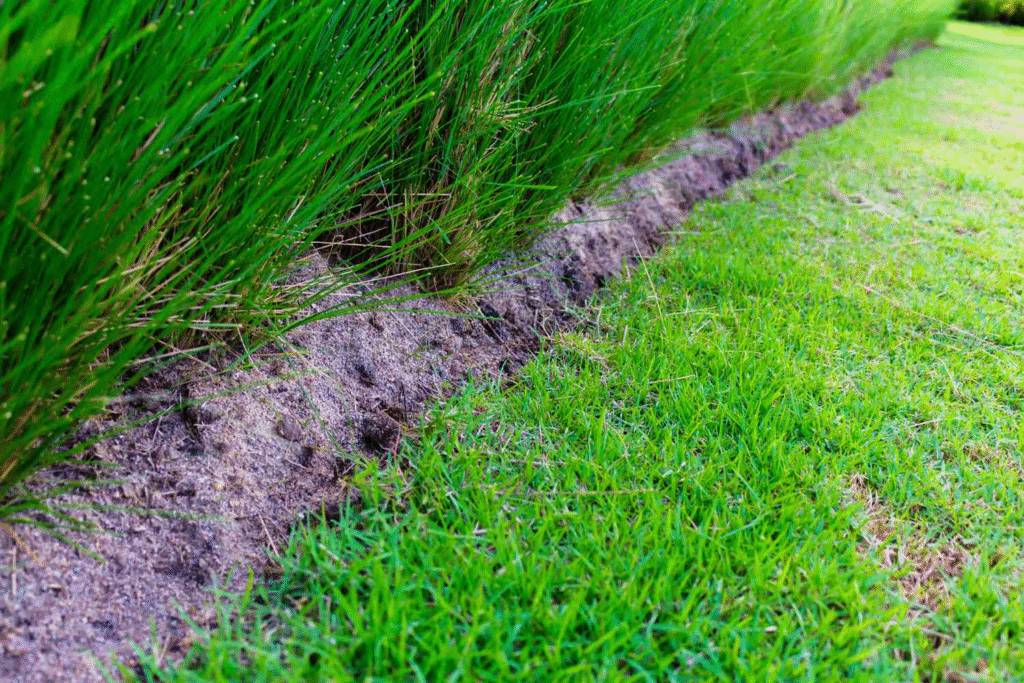
Mulch Materials: Different mulch materials offer varying levels of protection. Here’s a comparison:
| Mulch Type | Effectiveness Against Bermuda Grass | Longevity | Cost | Other Benefits |
|---|---|---|---|---|
| Pine Bark | High | 1-3 years | Moderate | Acidifies soil slightly |
| Cedar Chips | Very High | 2-3 years | High | Natural pest repellent |
| Pine Straw | Moderate | 6-12 months | Low | Good for acid-loving plants |
| Hardwood Chips | High | 1-2 years | Moderate | Improves soil structure |
| Landscape Fabric + Mulch | Excellent | 3-5 years | High | Most effective combination |
Landscape Fabric: Before applying mulch, consider laying down landscape fabric or similar weed barrier material. Choose a high-quality, permeable fabric that allows water and nutrients to reach your plants while blocking Bermuda grass growth. Secure the fabric with landscaping pins and overlap seams by at least 6 inches.
Smart Gardening Practices
Your regular gardening habits can either help prevent or inadvertently encourage Bermuda grass invasion:
Strategic Watering: Water deeply but infrequently, focusing on the base of your plants rather than broadcasting water across the entire bed. This approach benefits your garden plants while making the environment less hospitable for Bermuda grass.
Fertilization Practices: Apply fertilizer directly to your garden plants rather than broadcasting it across the entire bed. Bermuda grass thrives in nutrient-rich environments, so limiting fertilizer application helps reduce its vigor.
Plant Density: Maintain dense plantings in your flower beds. Closely spaced plants create shade and competition that can help suppress Bermuda grass establishment.
Eradication: Removing Established Bermuda Grass
Despite your best preventative efforts, you may still find Bermuda grass in your flower beds. Here are effective eradication methods:
Manual Removal Techniques
Hand-pulling Bermuda grass can be effective for small infestations if done thoroughly and consistently:
Proper Extraction: Water the area thoroughly beforehand to loosen the soil. Using a garden fork or specialized weeding tool, dig around the grass clump to expose the entire root system. Pull slowly and steadily to remove as much of the rhizome network as possible.
Persistence Required: Plan on regular inspections and removal sessions. Even small rhizome fragments can regenerate into new plants, so thoroughness is essential. Check your flower beds weekly during growing season and remove any new grass shoots immediately.
Solarization: For heavily infested areas that you’re willing to clear completely, solarization is an effective organic method. Clear the bed of all plants, water it thoroughly, then cover with clear plastic sheeting secured at the edges. The sun will heat the soil to temperatures that kill Bermuda grass roots and seeds. This process typically takes 4-8 weeks during hot summer months.
Targeted Chemical Controls
When manual methods aren’t enough, careful application of herbicides can help control Bermuda grass:
Non-Selective Herbicides: Products containing glyphosate can be effective against Bermuda grass but will also kill other plants they contact. For targeted application in flower beds, consider using a wiper applicator or shield to protect desirable plants.
Grass-Specific Herbicides: Products containing fluazifop, sethoxydim, or clethodim target grasses specifically while leaving most broadleaf plants unharmed. These are good options for beds containing perennials and shrubs, but not other ornamental grasses which would also be affected.
Application Timing: Herbicides are most effective when applied to actively growing Bermuda grass. The optimal time is when the grass is at least 3-4 inches tall but before it starts producing seed heads.
Multiple Treatments: Due to Bermuda grass’s resilience, plan on multiple herbicide applications spaced 2-4 weeks apart. The first application will kill visible growth, while subsequent treatments target regrowth from surviving rhizomes.
The Environmental Protection Agency (EPA) provides guidance on safe herbicide use for homeowners. You can find information about responsible chemical applications here.
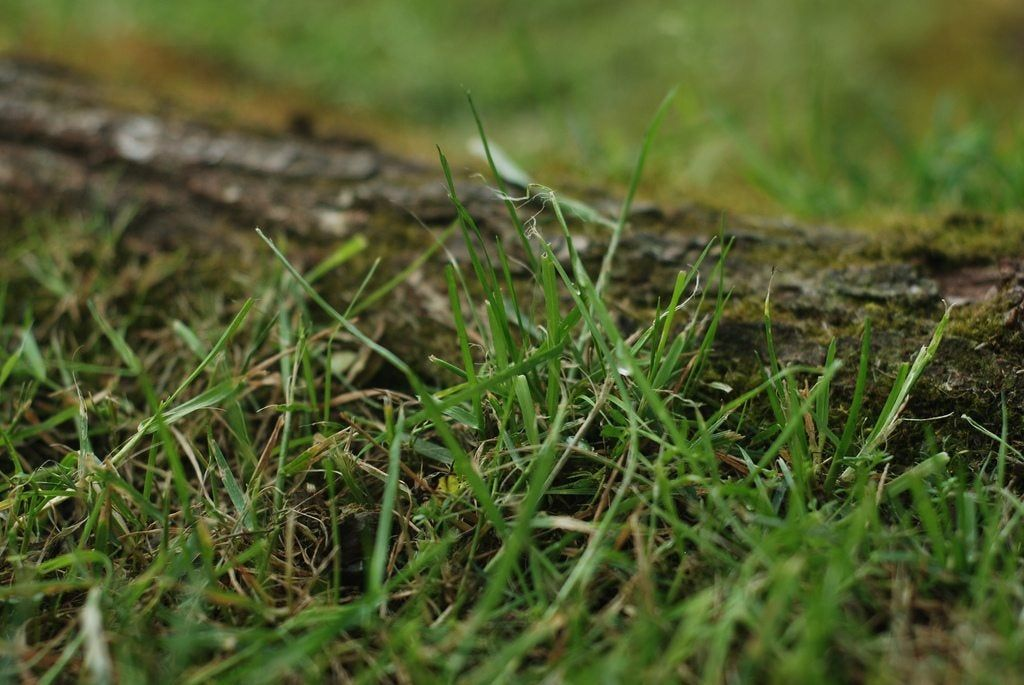
Organic Alternatives
If you prefer to avoid synthetic chemicals, consider these organic approaches:
Vinegar Solutions: Horticultural vinegar (20% acetic acid) can be effective on young Bermuda grass. It works best on sunny days when temperatures are above 70°F. Multiple applications will be necessary, and caution is required as strong vinegar can cause skin irritation.
Boiling Water: For small patches, particularly along edges or in cracks, boiling water can effectively kill Bermuda grass. This method works by essentially cooking the plant tissues. Be careful not to splash nearby desirable plants.
Organic Herbicides: Commercial organic herbicides containing ingredients like citric acid, clove oil, or d-limonene can provide control with less environmental impact than conventional options. These typically work by burning plant foliage rather than systemic action, so repeated applications are necessary.
Maintenance: Keeping Bermuda Grass at Bay
Once you’ve successfully removed Bermuda grass from your flower beds, consistent maintenance is crucial to prevent its return:
Regular Monitoring: Inspect your flower beds weekly during growing season for any signs of Bermuda grass re-emergence. Early detection is key to preventing re-establishment.
Edge Maintenance: Re-cut the edges between your lawn and flower beds every 2-3 months to sever any rhizomes attempting to cross the boundary.
Mulch Replenishment: Refresh your mulch layer as it decomposes to maintain the recommended 3-4 inch depth. This is typically needed once or twice per year depending on the mulch type.
Prompt Response: If you spot Bermuda grass trying to re-establish, act immediately. Remove it completely using the techniques described earlier before it has a chance to spread.
Advanced Strategies for Persistent Problems
If you’re dealing with particularly stubborn Bermuda grass invasions, consider these more intensive approaches:
Raised Beds: Converting to raised beds with solid bottoms or barriers can create a physical separation between your garden soil and the Bermuda grass-infested ground below. Ensure the beds are at least 12 inches high and include a barrier extending at least 6 inches below ground level at the perimeter.
Soil Replacement: For extreme cases, removing the top 6-8 inches of soil and replacing it with clean, Bermuda grass-free soil can provide a fresh start. This is labor-intensive but effective when combined with proper barrier installation.
Groundcover Competition: Planting aggressive, low-growing groundcovers in your flower beds can help outcompete Bermuda grass. Species like creeping thyme, creeping jenny, or ajuga can form dense mats that discourage grass establishment.
Season-Specific Strategies
Timing your control efforts to coincide with Bermuda grass’s natural growth cycle can improve your results:
Spring (March-May): As Bermuda grass emerges from dormancy, it’s vulnerable to control methods. Apply pre-emergent herbicides to prevent seed germination, reinforce barriers, and begin manual removal of any visible growth.
Summer (June-August): Bermuda grass is at peak growth. Focus on consistent monitoring and prompt removal of any invasions. This is also the best time for solarization if needed.
Fall (September-November): As growth slows, take advantage of the reduced spread rate to thoroughly remove established plants. Systemic herbicides are particularly effective during early fall when the plant is moving nutrients to its roots.
Winter (December-February): In colder regions where Bermuda grass goes dormant, use this time to prepare for next season. Strengthen barriers, apply fresh mulch, and plan your spring strategy.
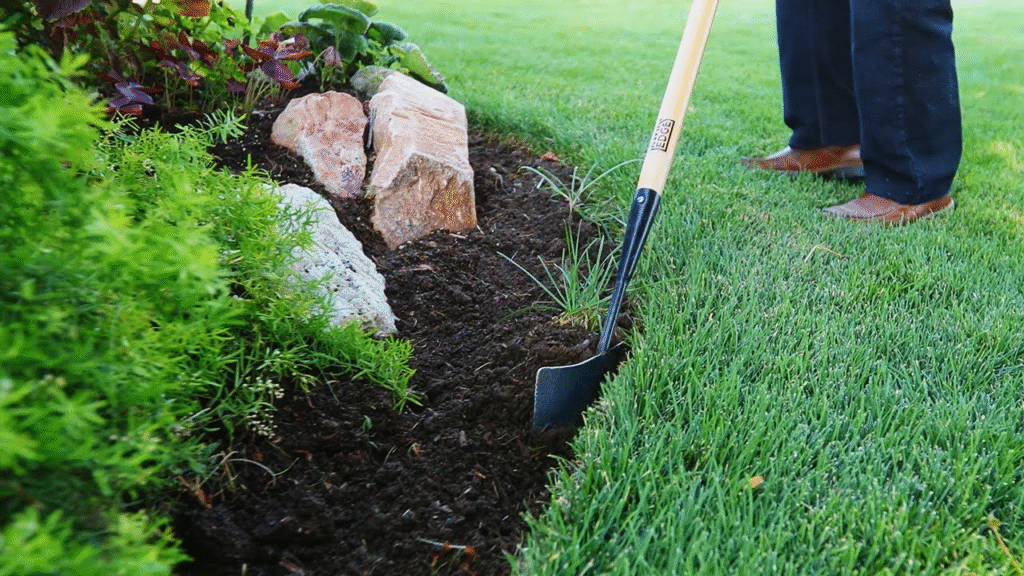
Common Mistakes to Avoid
Many gardeners make these errors when battling Bermuda grass:
Shallow Removal: Pulling only the visible portion of Bermuda grass leaves rhizomes intact, allowing quick regrowth. Always dig deep enough to remove the entire root system.
Improper Barrier Installation: Barriers that are too shallow or have gaps will quickly be breached by Bermuda grass. Ensure barriers extend at least 6-8 inches below ground and are properly sealed at joints.
Inconsistent Monitoring: Letting your guard down after initial success often leads to reinfestation. Regular inspection and maintenance are essential for long-term control.
Contaminated Compost or Soil: Introducing new soil or compost that contains Bermuda grass seeds or rhizomes can undo all your hard work. Source materials carefully or consider composting at high temperatures to kill seeds.
Conclusion: Victory in the Long Game
Controlling Bermuda grass in flower beds requires understanding its growth habits, implementing effective barriers, and being vigilant with maintenance. Remember that this is a marathon, not a sprint. With consistent effort applying the techniques outlined in this guide, you can successfully keep Bermuda grass where it belongs—in your lawn, not your flower beds.
By combining preventative measures with prompt response to any breaches, you’ll gradually gain the upper hand in this common garden challenge. The beauty of your flower beds will be worth the effort, and you’ll develop valuable skills applicable to other garden management tasks.
For additional resources and expert advice, consider consulting your local extension office. They can provide regionally specific guidance tailored to your particular growing conditions and challenges. The National Institute of Food and Agriculture provides a directory of extension offices here.
With patience, knowledge, and persistence, you can successfully keep Bermuda grass out of your flower beds and enjoy the beautiful garden you’ve worked so hard to create.
